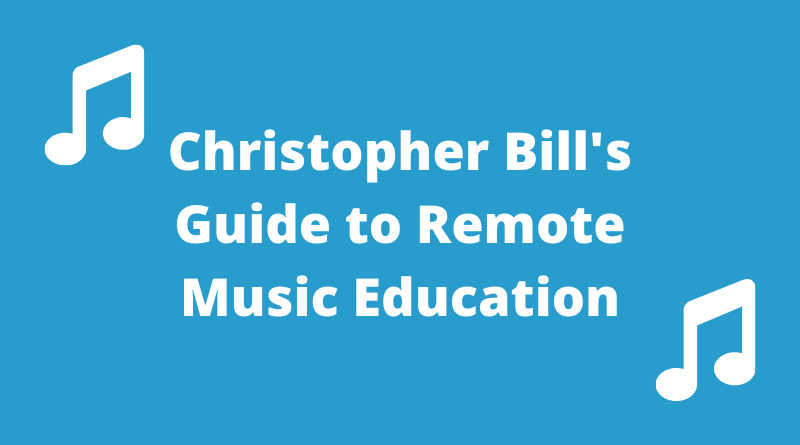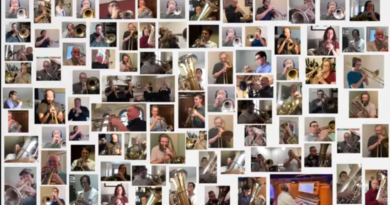Christopher Bill’s Guide to Remote Music Education
Editor’s Note: Due to the recent outbreak of COVID-19 (Coronavirus), many schools and universities are having to adjust their teaching methods. Since a foundational element to music education is in-person/one-on-one instruction, trombonist Christopher Bill (you may have seen him on YouTube) has created an excellent resource for how to bring your music teaching to a remote classroom. This article has been republished on Last Row Music with permission from Christopher Bill. If you find value in this resource, please consider supporting him via Patreon. – Jeremy
Christopher Bill’s Guide to Remote
Music Education
Hi all! Here’s a quick go-to list of software/apps you can use to stay connected with your students remotely and encourage progress without the luxury of in-person teaching.
Communication Software & Apps
Easy One-On-One Video Chat Services
- Google Duo (Android/iPhone/Computer cross-compatible)
- Facebook Messenger (Android/iPhone/Computer cross-compatible, need Facebook)
- FaceTime (iPhone only, so not ideal)
- Skype & Google Hangouts work fine for one-on-one but are unnecessarily clunky if all you’re looking for is a quick and easy face-to-face.
Multi-Person Group Video Chat Services
- Skype (100-person max, iPhone/Android/Computer & phone number call-in, screen-share)
- Zoom Meeting (100-person, 40min max free-plan, iPhone/Android/Computer & phone number call-in, Recording feature saves meetings, need more, $15/month plan is good)
- Google Hangouts (10-person max, iPhone/Android/Computer & phone number call-in)
- Facebook Messenger (50-person max, iPhone/Android/Computer, need Facebook)
- FaceTime (32-person max, iPhone-only, so not ideal)
Remote Live Lecture/Masterclasses (one person broadcasting to many)
- Crowdcast – $29/month basic plan, has app
- 2 hour session limit, video playback after event, option to charge for viewing
- Integrated chat for students
- Students can submit questions and up-vote questions already submitted
- Can invite students or guests to join on screen for a true virtual masterclass setting
- I don’t have experience with other services, but there are alternatives
Forum-Style Communication
- Discord – Not incredibly user-friendly to set up. You can have a student who is familiar with the platform set it up, dig in and watch some YouTube tutorials, or I’m happy to consult and help you get started. It’s an incredible free option and great for group communication, sending out updates, and keeping students accountable all in one place. Here’s my Discord server to see some ways it’s used.
- Slack – The “professional cousin” of Discord. Paid plans unlock more group collaboration, document storage, etc.
- Facebook Groups – Not every student is going to have a Facebook account, so not ideal, but very user friendly to set up and use. No phone notifications for announcements and messages like with Discord and Slack.
Other Resources
- Spotify Playlists – Pretty user-friendly for creating and sharing
- YouTube Playlists – Curate a list of videos for students to watch
- When signed into YouTube, click the little “+” to the left of “SAVE” under the video(s) you want to add, and then either create a new playlist or add to a current playlist listed. To access your current playlists, click the top left panel on the YouTube home screen. If not visible, click “Show more” and select the desired playlist. From there you can re-order videos and share that link to students.
- Noteflight Learn (free for music educators affected by closures through June 30) – Pretty comprehensive tool for creating sheet music assignments, composition assignments, recording students for assessments, and other cool remote teaching for “in your own time” style workflows. Similar to SmartMusic in some ways. Worth checking out.
- Speaking of, SmartMusic has changed over the years and it’s worth refamiliarizing yourself with it if you haven’t seen it in a while. Some really great stuff there if you’re willing to utilize it to its potential.
- Google Classroom – Comprehensive solution to managing virtual education
- Christopher Bill Lesson Courses 😁 (educators, ask for a free code and group discounts) Right now I have a giant three-part course on a range building, a cool course on learning intervals/triads/7th chords, and a course on learning key signatures. In the next week or two I should have my course/play-alongs for major scales up as well. Anybody interested, please reach out and I’ll give you a free access code to see if it’s something you might want for your students.
- The Shed – Great digestible lessons for theory, notation, rhythm, improvisation, etc.
- Jam of the Week – Facebook community for improvisation and feedback from professionals.
Okay! Now what to do with all of this…
Traditional Ideas
One-on-one lessons
- Make sure to mute yourself when your student is playing and vice versa or both use headphones to avoid audio dropping out.
- Use what you have. There’s no need to run out and buy expensive hardware (although if you do, I’d recommend something like the Shure MV88 microphone that plugs straight into your phone). A little trial and error goes a long way. Try with headphones, try with muting, etc.
- If you’re having internet speed problems, try turning off your video if you’re not actively demonstrating something.
Video Masterclasses
- Depending on your studio size, you can even just use one of the free options above and have one student perform while the others can send written feedback as they play. I really recommend having everyone mute by default and just unmute when they are asking a question, giving feedback, or performing.
- Using the paid services like Crowdcast really make the experience more user-friendly and have fewer technical glitches (for example distractions like program sounds when people come on or off the session in something like Skype).
- Can bring in guest artists to listen to students, perform, speak, and do Q&As. If you ask a guest to do something like this from the comfort of their own home, their prices are typically half what their live fee would be. Of course it’s not the same as that in-person connection, but for something like a Q&A it can be darn close!
Recording Assessments
- Using one of the forum-style communication sites, upload assignments for students to record on their own and upload for you to give feedback on.
- Can keep these private by having students upload them privately (either directly to these sites or through a 3rd party hosting site like Google Drive, DropBox, WeTransfer, MediaFire, etc.
“Jam of the Week” or “Etude of the Week”
- You can have your students do the actual jam of the week on Facebook (and there are others, like Trombone Etude of the Week), or make your own using one of the forum-style services to assign students a new piece for everybody to practice and post a performance of by the end of the week. You can either do it as a one-on-one assignment that others can watch or encourage feedback between students.
Listening Assignments
- Have students listen to a recording, watch a video (or a series of them using the playlist services above) and use the forum-style communication to have a “book club” discussion about them.
Research Projects (as formal or informal as you want)
- Students research artists, pieces, historical events, etc.
- They can present their projects through forum-style communication
- They can present their projects through a group video-chat or crowdcast
- Personally, my favorite would be for them to present by informally telling the other students about what they found on a video chat, and then having the other students ask questions about it and the educator can guide the discussion that follows.
Non-Traditional Ideas
Virtual Recitals
- Students take turns performing short solo pieces and etudes they’ve worked on, opening up the viewing to family and friends.
- Can create traditional posters and advertise them on social media, as it still would be a “live event”
- Would work best with something like Crowdcast, with the professor acting as MC. You’ll want to do a dress rehearsal to make sure you’ve got the functionality down (inviting students to present in the software so they can broadcast their video, and how to take back control when they’ve finished).
Watch Parties
- You can schedule a time to watch full-length concert videos. (There are so many great full-length concerts on YouTube and other sites like Naxos/Medici.)
- Sync it up with a watch-party site (they’re free, easy to set up, most have integrated chat functions, and some have slightly annoying ads, so try them out and see what you like.)
Social Media “Challenges”
- Have students post small videos of themselves practicing on their social media accounts. There’s a popular “100 day challenge” students are doing, but a pretty reasonable 7-day challenge would be a good start.
- I should say there are some mixed feelings about if folks should be posting in-progress videos when they could just practice and then post a video that sounds pretty good… I’ll let you have that debate for yourselves. All I know for sure is that if their friends will see it, they’ll practice harder!
- I’ve also seen challenges where somebody will post a video of themselves playing a tricky lick, lip slur, vocal riff, etc. and then others will try to do it themselves. Depending on your students’ ability level (and the disparity between them) this could be a really fun way to say- go practice and then show off this short but flashy technique.
Virtual Choir Recording Projects
- Choose a piece
- Create a click track for students to play with (or if the tempo stays the same, just have students play with a metronome in headphones)
- Have the students record and send in audio
- Edit them together (or pay somebody to… Hello! Contact me for pricing!)
- You can do this with just audio or a big video
- Here’s a video I was hired to arrange, record, and edit for a high school. Again, I’m happy to do this for your groups depending on the size of the ensemble and scope of the project. Audio-only projects take much much less time (and money!) I’m also happy to consult and help you if you have questions and are trying to do it on your own.
- This all can be applied to multi-track videos like the stuff I’m known for, where one student would for example play all of the parts to a quartet and layer themselves. Our intonation tendencies are learned FAST with one recording. Apps like the acapella app make these super accessible.
If you have questions about ANY of this, please reach out to me and ask so I can update this document for the next person who might have those questions. If we know each other, just shoot me a message. If not, just send my assistant Ford a note at [email protected] and we’ll get right back to you!
Same goes for if you want to hire me to do a virtual performance, masterclass, edit your projects, or consult to get any of this stuff setup for you!
Thanks and stay safe!
CB
P.S. – If you found this helpful and want to support, feel free to hop over to Patreon 🙂
This article has been republished on Last Row Music with permission from Christopher Bill.



